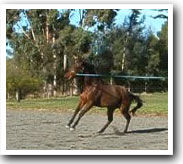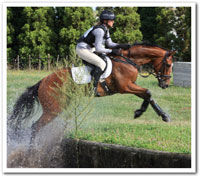When Susan bought ‘Millie’; a Sir Tristram bred TB in March of 2007 for her daughter Carmel, she was everything she was wanting for her next horse...
Calm and quiet, with a fantastic temperament, she had already proven herself as a Show Hunter finishing 6th nationally on the 2006 Circuit.
She took to eventing well, placing in all but one event in the 2007 season and consistently scoring in the high 60’s in the winter dressage series.
She was turned out for a spell over Xmas 2007, but when she was brought back into work a couple of months later she was not the same horse she had been previously.
For some unknown reason ‘Millie’ could not even maintain canter and would ‘bunny hop’ with both back legs together and she had lost the ability to jump, taking rails at 70cms with her hind legs.
“We were very worried” Susan said, as she had also lost a considerable amount of condition.
“My heart sank when the vet suspected a fractured pelvis or serious damage to the sacro-iliac joint”.
‘Mils’ was booked in to have a scan which involved being injected with radio-active dye. The results were inconclusive so a series of nerve blocks were conducted to narrow down the location of the problem, once again with inconclusive results.
‘Mils’ then went home and, on advice from Massey, Susan and Carmel tried high doses of bute, but again no change.
“We have tried every treatment under the sun over the last 18 months including chiropractors, acupuncture, laser treatment and massage but while some resulted in temporary improvements. She would rapidly deteriorate again. It was very depressing”.
When the vet’s next suggestion was to go into the stifles surgically, all Susan could see was more huge bills with no results. With the costs having mounted by now to thousands of dollars, they refused this option and turned ‘Mils’ out again.
Then, while surfing the internet back in May, Susan came across Alleviate and my website. Reading some of the articles she had a ‘light bulb’ moment that maybe ‘Mils’ issues just might be grass related.
That’s when I received the call for help via e-mail from Carmel.
As I live close by I was able to pay a visit. On the lunge the horse couldn’t canter without ‘bunny-hopping’ and swapping leads behind.
‘Mils’ was very agitated so we only did enough to record a ‘before’ video. Fortunately I have seen this same collection of symptoms in quite a few horses over the years, experiencing the very same problem with one of my own horses, so I knew I could help.
Milly was grazing short rye/ clover paddocks.
Put simply, these pastures, especially in early spring and autumn conditions, and especially when fertilized, become very high in potassium and nitrates and very low in sodium.
Whilst potassium competes for absorption with calcium and magnesium, the excess toxic nitrates latch on to calcium and magnesium and are excreted with them.
The horse’s body is thus ‘stripped’ of these essential minerals leaving not enough to run their large musculature and nervous system.
(Next to water, the electrolytes, sodium, potassium, calcium and magnesium run the body).
It is easy to see how this can be mistaken for a physical problem rather than a nutritional one.
The Solution...
Milly back to competing after diet changes!
The first thing to do was remove Milly entirely from the grass she was grazing - a dry lot needed to be established.
I recommended lots of hay, AlleviateC to assist with the calcium/magnesium deficiency, extra salt to help rectify the sodium: potassium ratio along with Premium NZ Horse Minerals.
It is necessary to add the salt to their feed, they won’t get enough from salt or mineral blocks.
Milly has improved over a period of a month to where she can now canter properly each direction and feels comfortable and calm again. HOW SIMPLE!
Milly's symptoms had become extreme. For every extreme case there are many more mild to moderate cases. To help you establish if your horse is affected in any way (the signs are many and varied), tick the boxes on the “Healthy Horse Checklist”.





